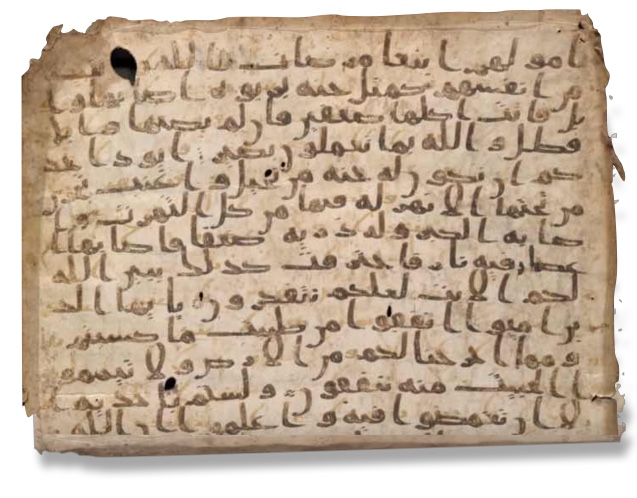
In 2000 a book by the German orientalist Christoph Luxenberg was published in which he presented a new reading of the mysterious passages contained in the Holy Qur’ān. The work was The Syro-Aramaic Reading of the Koran, a Contribution to the Decoding of the Language of the Koran.[1] In a series of articles we will discuss the summarised conclusions of the book.
BY KAMIL ALI
WHEN LEXICOGRAPHERS were unable to clarify the ambiguities in the language of the Qur’ān – despite the Almighty’s saying that it was revealed in ‘a clear Arabic tongue’ – commentators stepped in to say that these ambiguities were due to the language of the Quraysh, citing as evidence the words of the Almighty:
And We did not send any messenger but with the language of his people, so that he might explain to them clearly[2]
Taking this problem as starting point, new research is focusing on the actual language, particularly the written language that was widespread in the Arab East region during the period in which the Holy Qur’ān was put together.
This language is Aramaic, called ‘Syriac’ by the Greeks ever since the BC era, after the names Assyria in Mesopotamia and the actual Syria. The oldest Aramaic inscriptions discovered so far go back to the ninth century BC.
The Arameans who converted to Christianity were known as Syriacs to distinguish them from their pagan fellows, due to the fact that the name ‘Aramaic’ had become synonymous with paganism. In his commentary, al-Ṭabarī makes no mention of Aramaic, but instead uses the term Syriac.
The Prophet asked Zayd ibn Thābit to go to the Levant in order to learn Syriac
It was the translation into the Edessene Syriac of the Bible (the Torah and the New Testament) in 2nd century AD, or perhaps earlier, that raised the status of the Syriac language. This was the Aramaic spoken in the region of Al-Raha (also known as Edessa) which was located in northwestern Mesopotamia (the city is now the present-day Urfa in the southeast of the Turkish Republic).
With the Christianization in the late second century AD of King Abgar V, The King of Edessa, and the spread of Christianity by the Syriacs of Syria and Mesopotamia, Syriac became the the language of writing not only in Syria and Mesopotamia, but also in neighbouring regions, such as Persia and the Arabian Peninsula.
In the hadith it was mentioned that the Prophet asked Zayd ibn Thābit to go to the Levant in order to learn Syriac.[3] In commentaries on the Qur’ān it was also related how Ibn ‘Abbās was asked whether the two letters ṭā hā, which appear at the beginning of Sūrat Ṭā hā, were name of the Prophet Muḥammad. To this he replied: “It is a Syriac word,” This shows us the importance of the (Christian) Syriac language at the time when the Holy Qur’ān emerged and later too, since we know from the subsequent history of Arabic literature that the Syriacs played a major role in the development of literary Arabic with their translations from Syriac and Greek into Arabic during the Abbasid era. As a result of which the Arabic language took over from Syriac as the language of literature, philosophy and science.
We know that according to the inscriptions discovered since the ninth century BC ancient Aramaic began to be written down, and that Persian kings adopted it as their administrative language and used the Aramaic script to write Middle Persian (Pahlavi). It was also adopted as their language by the descendants of Israel following their exile to Babylon. They thus wrote down in Aramaic some of their holy scriptures, including the Book of Daniel.
In the Umayyad period Aramaic served, alongside Arabic, as the official language
Syriac is but an extension of ancient Aramaic with a Christian character in the AD era, and in the Umayyad period served, alongside Arabic, as the official language up until the reign of ‘Abd al-Malik ibn Marwān (685-705 AD). This demonstrates the close connection between Arabic and Syriac even in the post-conquest era.
Based on this confirmed historical backdrop, Christoph Luxenberg conducted linguistic research into an era approximately 150 years prior to the development of the rules of the Arabic grammar by Sibawayh (ob. 795 AD), on the understanding that the Arabic tongue revealed in the Qur’ān differs from the Arabic consolidated by circles of Arab and non-Arab grammarians.

Suggested Reading
The author questions the competence of these grammarians, especially those who were non-Arabs, in that they were ignorant of the ‘tongue’ in which the Qur’ān was revealed. These relied on the author of Jāmi‘ al-Bayān ‘an Ta’wīl al-Qur’ān Abū Ja’far Muḥammad ibn Jarīr al-Ṭabarī (839-923 AD), who was aware of the peculiar character of the language of the Qur’ān. He appealed to
“native speakers who have knowledge of the tongue in which the Qur’ān was revealed…. and those possessed clearest evidence as to what was to be translated and clarified”
to kindly interpret what they could from their knowledge, adding “whosoever that interpreter may be”.
Luxenberg points out that the Qur’ān is the first book to be written in Arabic, since there is no historical trace of any earlier writing other than some Nabataean inscriptions that evidence a language that is close to Arabic. In its early stages, much like its Nabataean counterpart, the Arabic script was devoid of diacritical dots and vocalisation. This is attested by many manuscripts, Qur’ānic and non-Qur’ānic, that are preserved in museums in the East and the West, the latest of which was discovered in the early seventies under the roof of the Great Mosque at Ṣan‘ā’.
There is a consensus that the distinctive diacritical dots of twenty-two letters of the Arabic alphabet were added to the Qur’ānic text only later, but there is still some ambiguity as to actually when the diacritical dots were added. It is, however, noticeable that the 9th/10thcentury al-Ṭabarī relied in his interpretation on a contemporary text that was dotted.
[1] See this work in the Almuslih Library here. (Ed.)
[2] Qur’ān XIV (Ibrāhīm), 4.
[3] The hadith in question is citied in (Jāmi` al-Tirmidhī 2715) and is also found in a longer version: ‘According to Zayd ibn Thābit: the Messenger of God said: “I have a number of writings, and I don’t want just anybody to read them. Could you learn Hebrew writing, or Syriac?” To which I replied: “Yes, and I learned them within 17 days!”’ See Ibn ‘Asākir, Tārīkh DImashq [I-LXXX, ed. Muhibb ad-Dīn al-ʽAmrawī, Beirut, Dār al-Fikr, 1995-2000], XIX, p.303. See also Ibn Saʽd, Al-Tabaqāt al-Kubrā and Ibn Hanbal, Musnad. (Ed.).
Main image: The Ṣan‘ā’ manuscript (c. 670 AD), the only known extant copy of the Qur’ān from a textual tradition other than the standard ‘Uthmanic tradition. It is a palimpsest (an erased and re-used parchment) with both the upper and lower text is written in what has been identified as the Hijazi script. The upper text conforms to the standard ‘Uthmanic Qur’ān and has been dated to between the 7th and 8th centuries, whereas the undertext is believed to have been written between 632-669 AD and contains many variants to the standard text. The manuscripts show how the Qur’ānic text developed and researchers have concluded that the original manuscript is much more likely to be from before the standardisation, because of the variations in the text and the size of the document.
